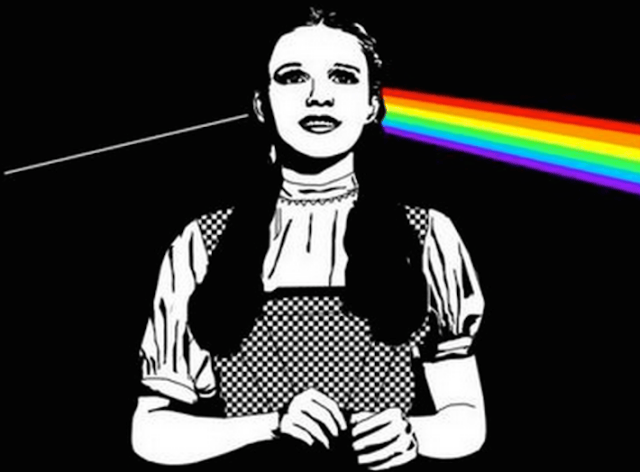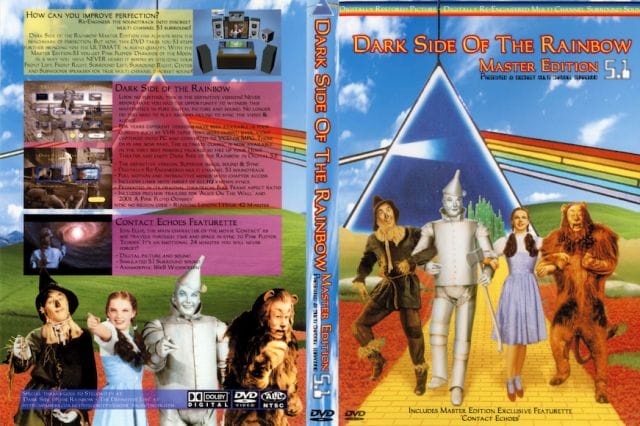Few albums ever achieve the unanimous recognition of Pink Floyd’s The Dark Side of the Moon. Released in 1973, the 43-minute long concept album tackled massive themes — greed, mental illness, the passage of time, and personal conflict — and propelled Pink Floyd into the echelons of rock immortality.
Upon its release, Dark Side of the Moon topped the Billboard charts and remained on the list for 741 weeks — from 1973 to 1988 — and proceeded to sell nearly 50 million copies worldwide, making it one of the top-ten best-selling albums of all time. More than four decades later, the British psychedelic rock band’s greatest work still sells 8,000 to 9,000 copies on any given week. One music scholar estimates that one in every fourteen people in the United States under the age of 50 owns, or has previously owned, a copy.
Recorded at London’s legendary Abbey Road Studios, The Dark Side of the Moon enlisted some of the most advanced, on-the-cusp recording technologies of the time — multitrack recording, tape loops, synthesizers, and effects — and intertwined voices, strange sounds, and undulating echoes with melodic choruses. Each “side” of the album is one continuous body of music, with each track representing a stage of life.
The ethereal nature of The Dark Side of the Moon (and the fact that a large portion of its listeners indulged in mind-altering substances) led to a strange observation: in the mid-nineties, users in an online forum pointed out that the album served as a perfect soundtrack for the 1939 film “The Wizard of Oz.” What ensued was years of speculation, drug-fuelled fan rants, and adamant denial by band members.
An Uncanny Coincidence
Sometime in April 1995, an internet user in a Pink Floyd discussion group mentioned that “some people down in Los Angeles” had set him onto a strange pairing. Simultaneously playing “The Wizard of Oz” (sans sound, starting at the MGM lion’s third roar) and The Dark Side of the Moon, claimed the user, would yield a slew of seemingly synchronized moments.
A few months later, Charlie Savage, a 20-year-old journalist with The Fort Wayne Journal Gazette, set out to uncover the truth behind this. He found himself pleasantly shocked:
“The result is astonishing. It’s as if the movie were one long art-film music video for the album. Song lyrics and titles match the action and plot. The music swells and falls with character’s movements…expect to see enough firm coincidences to make you wonder whether the whole thing was planned.”
Savage’s article in the Gazette, the first to thoroughly examine the phenomenon, coined the movie-album match “The Dark Side of the Rainbow.” It was subsequently picked up by the Associated Press, and thousands of music and film enthusiasts were soon trying it out for themselves. Websites dissected and catalogued the commonalities, radio DJs tirelessly argued over Pink Floyd’s “intentional” effort to correlate the album with the film, and MTV news aired a lengthy segment exploring the concept. In 2000, Turner Classic Movies, who has owned the rights to “The Wizard of Oz” since 1986, even aired a version of the film with Dark Side as an alternate soundtrack, and endorsed the idea as “a fun concept.”
Fans seem to teeter a bit on the subject: some steadfastly believe that Pink Floyd crafted the album specifically for the film, while others brush off the similarities as synchronicities with no discernible causal connection. The match-ups, however are undeniable. In his original article, Savage elaborates on a few of the most notable:
* During [opening track] “Breathe,” Dorothy does a tightrope-like walk along the holding pen to the lyric “and balanced on the biggest wave.”
* The line “no one told you when to run” from “Time” is sung just as the scene switches to Dorothy running away from home to save Toto.
* “Home, home again” from the “Breathe” reprise is sung as the fortuneteller tells Dorothy to go home.
* “Don’t give me that do goody good bullshit” from “Money” comes as Glinda the Good Witch of the North floats in as a bubble.
* “Black… and blue” from “Us and Them” is sung as the Wicked Witch of the West appears dressed in black. That is shortly followed by “and who knows which is which” (witch is witch) as she and Glenda confront each other.
* “Brain Damage” — which begins at almost the same time as the movie’s “If I Only Had a Brain” — contains the lines “The lunatic is on the grass” and “Got to keep the loonies on the path.” This is just as the Scarecrow flops around like a madman on the grass and then on the Yellow Brick Road.
Pink Floyd devotees soon chimed in with their own observations. In alt.music.pink-floyd (an early online music discussion page), dozens of threads from 1995-96 point out lyrical and visual parallels. “When Dorothy and Toto see the traveling circus guy or whatever,” writes one user, “the song is playing ‘to hear the softly spoken magic spells’ while the guy is looking into the crystal ball.”
“I don’t care if it sounds unbelievable, but certain parts fit great,” writes another fan. “I went as far as to put the Disc on repeat, and it still fit unbelievably: As soon as Dorothy opens the door into Munchkin land, the cash register starts…The cymbal crashes on ‘Eclipse’ went exactly with the axe’s strikes into the door…Dorothy opens her eyes right when [the albums lyrics state] ‘Home, home again.’”
The marriage of “Oz” and Dark Side goes beyond lyrics: often, the film’s actions perfectly align with the album’s music. For instance, the album’s fifth track, “The Great Gig in the Sky,” features over four minutes of improvisational, wordless signing and seems to ebb and flow flawlessly with the tornado scene:
In another pairing, right as Dorothy puts her ear up against the Tin Man’s organ-less chest, Dark Side’s outro — a heartbeat sound effect — faintly resonates. Even the album and film’s breaks are coordinated: “Money” (the first song on the album’s second side) and the Munchkinland scene (the beginning of the film’s second part) start concurrently.
Then, of course, there is the most meta parallel: Dark Side of the Moon’s famous prism album cover harkens to “Somewhere Over the Rainbow,” the film’s famous track, and symbolizes its “transition from black-and-white Kansas to Technicolor Oz.”
The Band Speaks

While fans have invested thousands of hours investigating the correlations between The Dark Side of the Moon and “The Wizard of Oz,” members of Pink Floyd have adamantly — and repeatedly — brushed them off as mere coincidence.
In a late-90s interview, Guitarist and vocalist David Gilmour scoffed at the idea, stating that it was the brainchild of “Some guy with too much time on his hands.” Nick Mason, the band’s drummer, jokingly chimed in: “It’s absolute nonsense. It has nothing to do with The Wizard of Oz. It was all based on ‘The Sound of Music.’”
During a 2002 MTV special, the band again laughed at the notion that they’d intentionally written the album for “Oz,” clarifying that there were “no means of reproducing the film in the studio” at the time they recorded the album. Film critic Richard Roeper confirmed this in his 2001 book Hollywood Urban Legends, noting that if Pink Floyd truly had wanted to mimic the 101-minute film, the album wouldn’t have clocked in at a mere 43 minutes.
Alan Parsons, Pink Floyd’s legendary audio engineer, had the most to say on the topic. In a 2003 interview with Rolling Stone, he essentially called the phenomenon hogwash:
“It’s such a non-starter, a complete load of eyewash. I tried it for the first time about two years ago. One of my fiancée’s kids had a copy of the video, and I thought I had to see what it was all about. I was very disappointed. The only thing I noticed was that the line ‘balanced on the biggest wave’ came up when Dorothy was kind of tightrope walking along a fence.
One of the things any audio professional will tell you is that the scope for the drift between the video and the record is enormous; it could be anything up to twenty seconds by the time the record’s finished. And anyway, if you play any record with the sound turned down on the TV, you will find things that work.”
And that’s exactly what others have done. In the vein of Dark Side/“Oz,” fans have matched up countless other films and albums: Pink Floyd’s song “Echoes” (from 1971’s Meddle), supposedly matches up with 2001: A Space Odyssey’s fourth act, “Jupiter and Beyond the Infinite;” Pixar’s WALL-E can similarly be synchronized with The Wall (1979). The strain isn’t Pink Floyd exclusive — according to several “stoner fan sites,” Metallica’s “The Black Album” perfectly accompanies “The Matrix,” just as Nirvana’s “Nevermind” matches 2001 thriller “Memento.”
But Parsons’ statement resonates the most reasonable explanation for all of this: synchronicity, or “coincidental events that seem related but are not explained by conventional mechanisms of causality.” According to the writings of psychotherapist Carl Jung, circumstances like “The Dark Side of the Rainbow” may merely be a result of confirmation bias — “the mind’s tendency to think it recognizes patterns amid disorder by discarding data that does not fit.”
Whether or not you buy the correlations discussed here, trying it out for yourself won’t do any harm. “Hey, worst case scenario, you don’t see the commonalities,” wrote one Pink Floyd forum user in 1997. “So what. You’ll hear a great album, and see a great film. Worse things could happen.”
This post was written by Zachary Crockett. Follow him on Twitter here, or Google Plus here.





